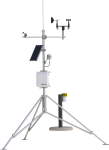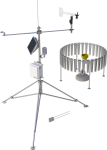What We Do
Campbell Scientific instruments are used in a wide variety of environmental-research applications. Our data loggers are compatible with most sensors, and commonly measure meteorologic, hydrologic, and soil conditions. Data are often used in research facilities and applications evaluating relationships between different organisms as climate and other conditions change. Campbell soil sensor products are key to agricultural research, irrigation scheduling, forestry, watershed studies, leak detection, slope stability, and many other disciplines.
Learn moreCheck out some awesome examples of what our equipment can do in this area
Personalice sus sistema
La mayoría de los sistemas que vendemos han sido personalizados. Cuéntenos sus necesidades y le ayudaremos a personalizar el suyo.
Instrumentación
We offer a variety of products that can be used to create systems for Environmental Research. Many of the major components used to create these systems are listed below. Please let us know if we can help you configure a system.
Documents
Mas detalles acerca de nuestro Environmental Research Sistemas
Data Loggers
At the core of our systems is a programmable data logger that measures the sensors, then processes, stores, and transmits the data. These data loggers have programmable execution intervals, wide operating temperature ranges, and on-board instructions for commonly used sensors. If needed, channel capacity can be expanded using multiplexers.
Data are typically displayed and stored in the units of your choice (e.g., wind speed in mph, m/s, knots). Measurement processing and data storage are programmable, but measurements are typically made every minute then processed and stored at hourly and daily intervals (e.g., maximum, minimum, average). Data can be measured and stored more or less frequently (depending on the application and conditional sampling) based on events such as increased wind speeds, torrential rainfall, or diurnal cycle.
Battery power and solar power allow our data loggers to provide remote, unattended data collection over long periods of time. Our instrumentation has been proven in some of the harshest environments in the world.
PC-based software is customized to simplify data logger programming, data retrieval, and report generation. The data logger program can be modified at any time to accommodate different sensor configurations or data processing requirements.
Sensors
Almost any sensor can be measured by our data loggers, allowing monitoring systems to be customized for each site. Typical sensors used on our stations include, but are not limited to: wind speed, wind direction, solar radiation of various types, air temperature, water temperature, soil temperature, relative humidity, precipitation, snow depth, barometric pressure, soil moisture, soil electrical conductivity, and soil heat flux. Our systems interface to a variety of sensors that measure water level and water flow, as well as water quality parameters such as pH, conductivity, and dissolved oxygen. Our data loggers can interface directly to most air flow sensors, opacity meters, particle samplers, and gas analyzers.
Communications
We offer multiple communications options for data retrieval, allowing monitoring systems to meet specific application requirements. On-site data retrieval options include storage module, laptop computer, PDA, and data logger keyboard/display. Telecommunication options include short-haul, voice synthesized telephone, cellular telephone, radio frequency, multidrop, and satellite. Options can be mixed within the same network. Robust error-checking and low power-use ensure your data arrives uncorrupted and as scheduled. You can even automate the process of putting your data on the Internet.
Casos de estudio
Imagine the bored mind of a space traveler as he looks around the room he......read more
A long-term scientific study to monitor trends in the biodiversity and structure of ecosystems of......read more
The Delaware Environmental Observing System (DEOS) is a real-time system dedicated to monitoring environmental conditions......read more
The Charles Sturt University (CSU) Rhizolysimeter is one of the largest root-growth research facilities in......read more
The Solar Decathlon takes place every other year on the National Mall in Washington, D.C.......read more
Acid Rock Drainage (ARD) problems associated with hard rock metal mining are one of the......read more
The Caribbean Marine Research Center (CMRC) was created in 1984 to address critical problems facing......read more
Construction of the Oslo, Norway airport was authorized on the condition that water supplies be......read more
Frequently Asked Questions
Number of FAQs related to Environmental Research: 4
Expand AllCollapse All
-
Yes. Refer to the instruction manual, which goes over the cup replacement procedure. For pricing and information on other models, contact Campbell Scientific.
-
The Kimberly R&E Center at the University of Idaho discusses crop coefficients for various crop types and talks about estimating evaporation from bare soil.
-
A weather station typically measures solar radiation, temperature, wind speed, and relative humidity. These parameters are then used to calculate evapotranspiration, which is then used as a starting point in the process of fine tuning an irrigation application to site-specific conditions. These conditions, such as soil type, can vary widely.
-
Most Campbell Scientific systems are built from individual components. This provides maximum flexibility for our customers, but it does not lend itself to pricing a "typical" system. Contact Campbell Scientific for assistance in pricing a system to meet the unique needs of the application.















